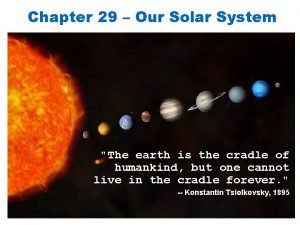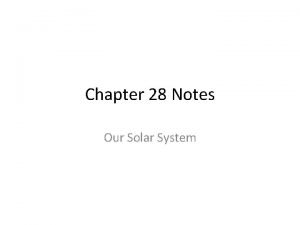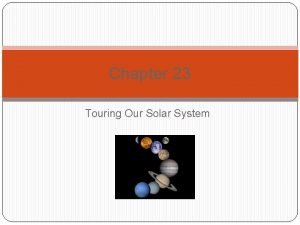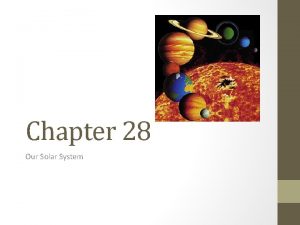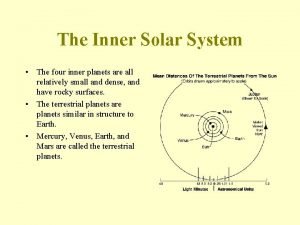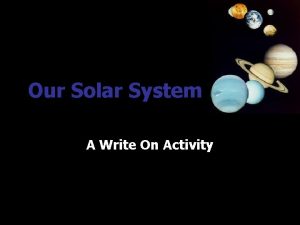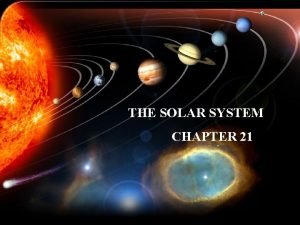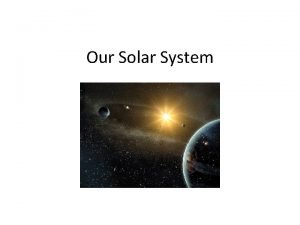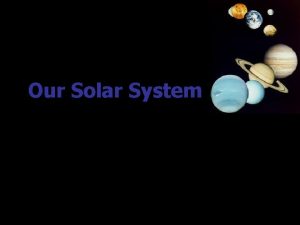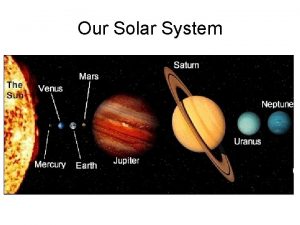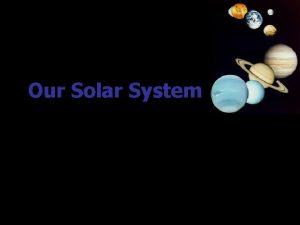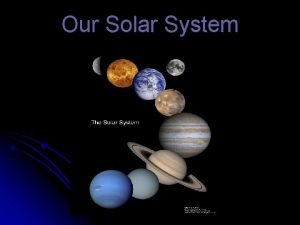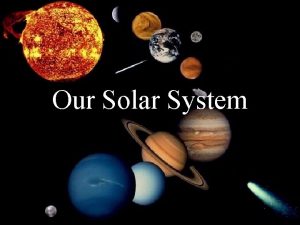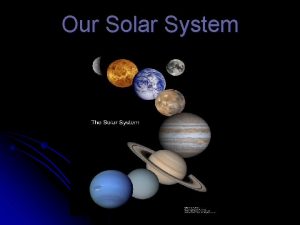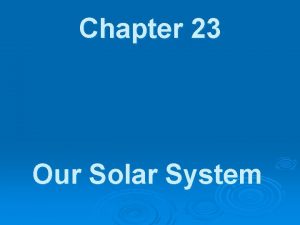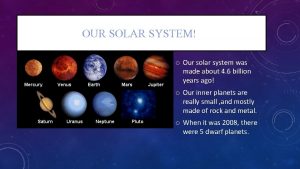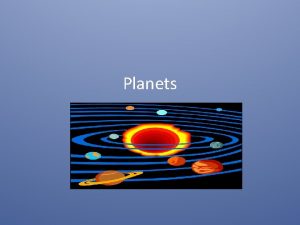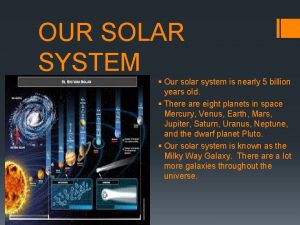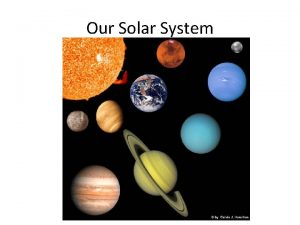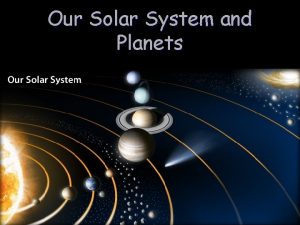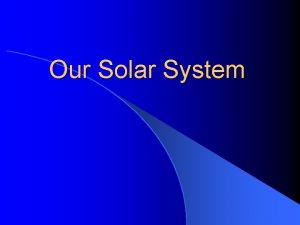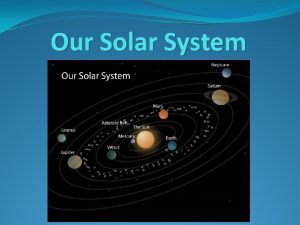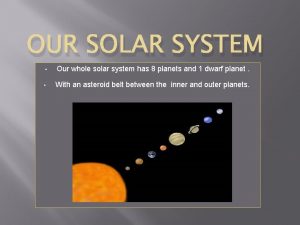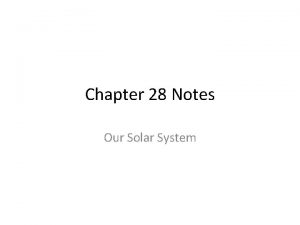Chapter 28 Our Solar System Our Solar System























- Slides: 23

Chapter 28 Our Solar System

Our Solar System • Big Idea: Using the laws of motion and gravitation, astronomers can understand the orbits and the properties of the planets and other objects in the solar system

Our Solar System • • 28. 1 – Formation of the Solar System 28. 2 – The Inner Planets 28. 3 – The Outer Planets 28. 4 – Other Solar System Objects

Our Solar System Quick facts • It is likely that Jupiter was the first planet in the solar system to form • It rains sulfuric acid on Venus • Mercury’s days are two-thirds the length of its years

28. 1 Formation of the Solar System

Formation of the Solar System • Objectives • Explain how the solar system formed • Describe early concepts of the structure of the solar system • Describe how our current knowledge of the solar system developed

Formation Theory • Theories of the origin of the solar system rely on direct observations and data from probes • Scientific theories must explain observed facts • • • Shape of the solar system Differences among the planets Nature of the oldest planetary surfaces Asteroids Meteoroids Comets

Big Bang Theory • No one knows what happened exactly • All the scientists know it that a marble sized universe was produced by a big bang and a large ball of heat started to grow • This ball kept expanding, but it didn’t contain matter it was all energy • Mass and energy are interchangeable • It changed these particles and matter • Short Explanation

Big Bang Theory • There was so much energy, the particles slowed down and created matter • The universe was then expanding • It all cooled, when protons and neutrons cooled • They combined to form Helium an Hydrogen • Video

Collapsing of Interstellar Clouds • Stars and planets form from interstellar clouds • These clouds are made mostly from hydrogen and helium gas with small amounts of other elements and dust • There is a gravitational force between all of these materials which is how it is thought our planets and stars formed

Collapse Accelerates • At first a collapse is slow but it gradually accelerates • It becomes much denser in the center • Eventually, the cloud becomes a rotating disk with a dense concentration of matter at the center

Matter Condenses • Because of this spinning and condensing of Hydrogen and helium scientists believe this is how the sun formed • There is high pressure and high temperature with this matter condensing • Because of this temperature gradient, different elements and compounds condensed at a certain distance away from the sun • This affected the distribution of elements in the forming of planets

As a result • Inner planets are higher and richer in melting point elements and the outer planets are more volatile elements • This also explains why the outer planets consists of gases and ices

Planetesimals • Because of these different particles were now condensing in our solar system, they grew as grains and collided • These colliding particles merged to form planetesimals • Planetesimals are objects hundreds of kilometers in diameter



Gas giants form • The first large planet to form was Jupiter • It grew from merging of icy planetesimals that contain lighter elements • Saturn grew similarly but not as large • Because each gas giant attracted material they all started to form rings and satellites

Terrestrial Planets Form • The terrestrial planets started to form from elements that resisted vaporization from the sun • Scientists also believe the sun swept much of the gas in the area of the inner planets • Thus, the inner planets didn’t develop satellites • Video

Debris • Material that remained after the formation of the planets and satellites is called debris • Eventually this debris diminished as they hit other planets or were diverted out of the solar system • Others formed into asteroids or comets • The asteroid belt formed because of Jupiter’s gravitational force

Kepler’s First Law • The laws are named after a German astronomer named Johannes Kepler (1571– 1630), who proposed them in the early 1600 s. • Kepler was able to summarize the carefully collected data of his mentor—Tycho Brahe—with three statements that described the motion of planets in a sun-centered solar system. • The laws are still considered an accurate description of the motion of any planet and any satellite.

Kepler’s First Law • An ellipse is an oval shape that is centered on two points instead of a single point • These two points are called foci


Kepler’s Second and Third Law • In addition to discovering the shapes of the planetary orbits, a planet does not orbit at a constant distance from the sun • Kepler has also shown that planets move faster when they are closer to the sun • The length of time it takes for a planet to travel a complete orbit around the sun is called its orbital period • Pg. 801 in your text • Video
 Chapter 29 our solar system
Chapter 29 our solar system Chapter 28 our solar system
Chapter 28 our solar system Chapter 23 touring our solar system
Chapter 23 touring our solar system Chapter 28 our solar system
Chapter 28 our solar system The four inner planets
The four inner planets What is the 2nd smallest planet in our solar system
What is the 2nd smallest planet in our solar system [email protected]
[email protected] Write about our solar system
Write about our solar system Wholesale photovoltaic solar panels
Wholesale photovoltaic solar panels An inexhaustible source of energy
An inexhaustible source of energy Solar system chapter
Solar system chapter Thinking language and intelligence
Thinking language and intelligence Our census our future
Our census our future Words to christ be our light
Words to christ be our light Marcus aurelius our life is what our thoughts make it
Marcus aurelius our life is what our thoughts make it We bow our hearts we bend our knees
We bow our hearts we bend our knees Our census our future
Our census our future Our life is what our thoughts make it
Our life is what our thoughts make it The poem money madness was published in the collection
The poem money madness was published in the collection Our awareness of ourselves and our environment
Our awareness of ourselves and our environment Awareness of ourselves and our environment
Awareness of ourselves and our environment God our father christ our brother
God our father christ our brother Our future is in our hands quotes
Our future is in our hands quotes Our awareness of ourselves and our environment.
Our awareness of ourselves and our environment.
